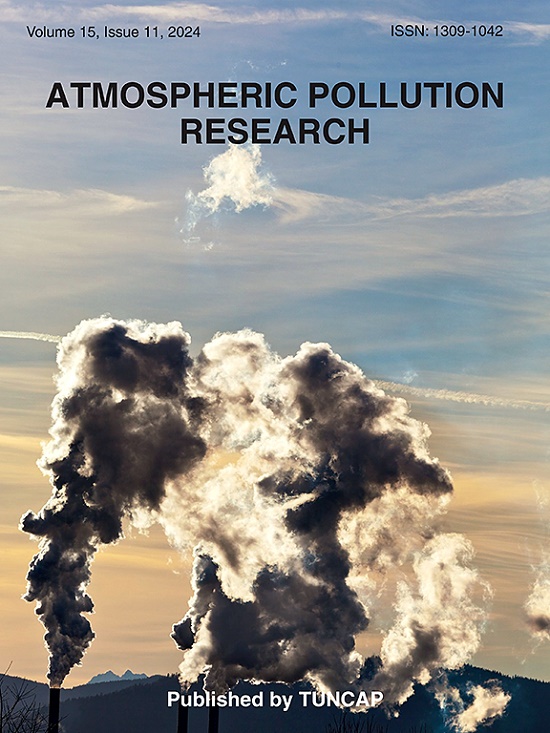How does greenness contribute to reducing lung cancer risks associated with particulate matter exposure?
IF 3.9
3区 环境科学与生态学
Q2 ENVIRONMENTAL SCIENCES
引用次数: 0
Abstract
The increasing global incidence of lung cancer, which now ranks first among all cancer types, along with the highest risk of lung cancer mortality in East Asia and the narrowing gender gap in incidence since the turn of the century, presents a significant and growing public health concern in Chinese cities. This research investigated how greenness affects the relationships between the incidence of lung cancer and PM1, PM2.5 and PM10 concentrations via a linear mixed model (LMM) and a generalized linear mixed model (GLMM). The findings revealed that particulate matter was associated with increased incidence of lung cancer, with the most substantial changes observed for PM1 (4.92), followed by PM2.5 (4.57) and PM10 (4.22). Our study also revealed that counties with higher levels of greenness experienced a decrease in the incidence of lung cancer among both males and females compared with counties with lower greenness levels, suggesting a protective effect of greenness against lung cancer. The joint associational analysis of particulate matter and NDVI greenness revealed elevated RRs of lung cancer incidence (male: 33 % for PM1, 40 % for PM2.5, 30 % for PM10; female: 43 % for PM1, 51 % for PM2.5, 42 % for PM10) in high particulate matter and low greenness (the highest-impacted group) relative to those exposed to low particulate matter and high greenness (the least-impacted group). The moderating role of greenness was stronger in females than in males (PM1: RERIfemale = 0.106; PM2.5: RERIfemale = 0.208, RERImale = 0.043; and PM10: RERIfemale = 0.139, RERImale = 0.017) and more pronounced in areas with medium greenness than in those with high greenness. These findings remained consistent in the smoking-adjusted and region-adjusted models and with an alternative index of the lung cancer mortality rate and greenness. These findings underscored the importance of urban greenness in the development of healthy cities.

绿色如何有助于降低与颗粒物暴露相关的肺癌风险?
全球肺癌发病率不断上升,目前在所有癌症类型中排名第一,加上东亚地区肺癌死亡率风险最高,以及自世纪之交以来发病率的性别差距不断缩小,在中国城市引起了重大且日益严重的公共卫生关注。本研究通过线性混合模型(LMM)和广义线性混合模型(GLMM)研究绿化程度如何影响肺癌发病率与PM1、PM2.5和PM10浓度之间的关系。研究结果显示,颗粒物与肺癌发病率增加有关,其中PM1的变化最为显著(4.92),其次是PM2.5(4.57)和PM10(4.22)。我们的研究还显示,与绿化水平较低的县相比,绿化水平较高的县男性和女性的肺癌发病率都有所下降,这表明绿化对肺癌有保护作用。颗粒物和NDVI绿色度的联合关联分析显示肺癌发病率的rr升高(男性:PM1为33%,PM2.5为40%,PM10为30%;女性:相对于暴露于低颗粒物和高绿色(受影响最小的组)的女性而言,高颗粒物和低绿色(受影响最大的组)中的PM1占43%,PM2.5占51%,PM10占42%。绿化对女性的调节作用强于男性(PM1: rifemale = 0.106;PM2.5: refemale = 0.208, reimale = 0.043;PM10: erefemale = 0.139, ereimale = 0.017),中等绿化地区比高绿化地区更明显。这些发现在吸烟调整模型和区域调整模型以及肺癌死亡率和绿色度的替代指数中保持一致。这些发现强调了城市绿化对健康城市发展的重要性。
本文章由计算机程序翻译,如有差异,请以英文原文为准。
求助全文
约1分钟内获得全文
求助全文
来源期刊

Atmospheric Pollution Research
ENVIRONMENTAL SCIENCES-
CiteScore
8.30
自引率
6.70%
发文量
256
审稿时长
36 days
期刊介绍:
Atmospheric Pollution Research (APR) is an international journal designed for the publication of articles on air pollution. Papers should present novel experimental results, theory and modeling of air pollution on local, regional, or global scales. Areas covered are research on inorganic, organic, and persistent organic air pollutants, air quality monitoring, air quality management, atmospheric dispersion and transport, air-surface (soil, water, and vegetation) exchange of pollutants, dry and wet deposition, indoor air quality, exposure assessment, health effects, satellite measurements, natural emissions, atmospheric chemistry, greenhouse gases, and effects on climate change.
 求助内容:
求助内容: 应助结果提醒方式:
应助结果提醒方式:


